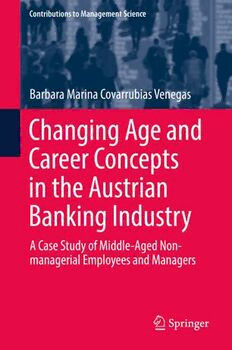
Changing Age and Career Concepts in the Austrian Banking Industry: A Case Study of Middle-Aged Non-managerial Employees and Managers PDF
Preview Changing Age and Career Concepts in the Austrian Banking Industry: A Case Study of Middle-Aged Non-managerial Employees and Managers
Contributions to Management Science Barbara Marina Covarrubias Venegas Changing Age and Career Concepts in the Austrian Banking Industry A Case Study of Middle-Aged Non- managerial Employees and Managers Contributions to Management Science Moreinformationaboutthisseriesathttp://www.springer.com/series/1505 Barbara Marina Covarrubias Venegas Changing Age and Career Concepts in the Austrian Banking Industry A Case Study of Middle-Aged Non-managerial Employees and Managers BarbaraMarinaCovarrubiasVenegas DepartmentofManagement UniversityofAppliedSciences forManagement&Communication Vienna,Austria ISSN1431-1941 ISSN2197-716X (electronic) ContributionstoManagementScience ISBN978-3-030-22608-4 ISBN978-3-030-22609-1 (eBook) https://doi.org/10.1007/978-3-030-22609-1 ©SpringerNatureSwitzerlandAG2019 Thisworkissubjecttocopyright.AllrightsarereservedbythePublisher,whetherthewholeorpartofthe materialisconcerned,specificallytherightsoftranslation,reprinting,reuseofillustrations,recitation, broadcasting,reproductiononmicrofilmsorinanyotherphysicalway,andtransmissionorinformation storageandretrieval,electronicadaptation,computersoftware,orbysimilarordissimilarmethodology nowknownorhereafterdeveloped. Theuseofgeneraldescriptivenames,registerednames,trademarks,servicemarks,etc.inthispublication doesnotimply,evenintheabsenceofaspecificstatement,thatsuchnamesareexemptfromtherelevant protectivelawsandregulationsandthereforefreeforgeneraluse. The publisher, the authors, and the editorsare safeto assume that the adviceand informationin this bookarebelievedtobetrueandaccurateatthedateofpublication.Neitherthepublishernortheauthorsor theeditorsgiveawarranty,expressorimplied,withrespecttothematerialcontainedhereinorforany errorsoromissionsthatmayhavebeenmade.Thepublisherremainsneutralwithregardtojurisdictional claimsinpublishedmapsandinstitutionalaffiliations. ThisSpringerimprintispublishedbytheregisteredcompanySpringerNatureSwitzerlandAG. Theregisteredcompanyaddressis:Gewerbestrasse11,6330Cham,Switzerland Foreword Inthesecond halfofthetwenty-firstcentury,oldpeoplewilldominate.Byaround 2060, about 30 percent of the Austrian population will consist of people aged 65+ withasimilarsituationexpectedinotherEuropeancountries.Thisphylogenetically unique situation concerning almost all advanced civilizations no doubt brings a number of positives and hopes for the future as well. For the first time in human history, we have a realistic chance of living a long life in an adequate health condition. We see the worries about the economic burden and disharmony of the labourmarketduetotheageingofpopulationasachallengeinspiringustoresearch andtomakeenquiriesanddetailedanalyses.Oneoftheavenuesofresearchopening upisconcernedwithequalopportunities,focussingonthedetectionandelimination of explicit and latent forms of ageism; next a redefinition will be necessary of productivity theories with respect to the new challenges to the production and to ourlivesbyautomation,digitization,robotizationandartificialintelligence. From this point of view, the monograph is concerned with a topical subject addressing the key political, economic and social issues of the present time. The questions of career concepts of ageing employees in these times of demographic changeinAustriaandotherEuropeancountriesareofhighimportance.Thechoice of the subject can be evaluated as unambiguously correct. The theoretical back- groundintheformofliteraturereviewispresentedinalargescopeandcoversthe whole problematic in a structured form. Firstly, two main models explaining the processofageingarepresented:deficitmodelandlifespanpsychology.Nextpartsof the literature review are dedicated to age groups, generations, norms, stereotypes, discrimination,agediversity,HRmanagementpracticesandperspectivesofmiddle- agers. The last chapter, Critical Reflection on Age and Careers Literature, also reflectsthegenderperspectiveofthetopic.Theauthorhaschosenacombinationof case study (the Austrian banking industry) and qualitative research design (inter- views with 25 respondents) to fulfil the aim of the study. Five main research questions were formulated in the beginning of the research; moreover, in two questions, the author emphasized the importance of the differences between the genderofrespondentsandtheirhierarchicallevels.Theauthorappliedanadequate v vi Foreword tool, Atlas.ti, to provide the data analysis. The results are well structured and well presented,includingthequotationsfromtheinterviews,andbringintriguingdetails insidetheproblemsofmiddle-agersinAustrianbankingindustry. Barbara Covarrubias Venegas has chosen an important research topic that requiresademandingapproachwiththesolutionsbroughtbeingpotentiallybenefi- cial.Itismyhopethatthereadersofthebookalsoreflectonthistopicandlookat themselves,theirownlives,andwhattheyseeforthefutureoftheirlivesandcareer concepts. MendelUniversityinBrno,Brno,CzechRepublic MartinaRašticová December10,2018 Preface Demographicchangeisaphenomenonthatischangingsocietiesandorganizations alike.Statisticalanalysisshowsaclearpicture:averageagesarerisingasaresultof decliningbirthratesandincreasinglifeexpectancy.Althoughageingaffectsevery- one in different ways, there is still a tendency for more negative stereotypes to be applied to older individuals, while positive ones are mainly applied to younger people. The effects of negative stereotyping usually entail exclusion regarding training and career opportunities within organizations as well as in the labour market. This challenge is exacerbated by the rising retirement ages and the oft- proclaimed need for lifelong learning at Austrian and European levels. For many decades, career researchers have proclaimeda turningaway from traditional, orga- nizational careers toward modern, protean and boundaryless careers, which has subsequentlyledtotheresponsibilityforcareerdevelopmentlyingwiththeindivid- ual. Thisrequires new anddifferent careercompetenciesandisparticularlyimpor- tantinindustriesthatareundergoingfundamentalchanges. The middle-aged group, i.e., 38–55-year-olds, has so far been given little atten- tioninscientificdiscourseinthisregard,although,today,middle-agedpeoplearethe largest age group within organizations. This research highlights the age and career conceptsintheAustrianbankingsectorandhowagestereotypesinfluencetheway middle-agersexperiencecareeropportunitiesandbarriers.Moreover,thisstudyaims at identifying changes in career concepts of middle-agers and, building on this, discusses implications for human resources management. The qualitative research approach (25 problem-centered interviews) of this project takes into account the exploratorynatureofthestudy. The main results show that although negative stereotypes prevail, positive ste- reotypesaremoregroundedinthedata.Atfirstglance,themiddle-agersseemtobe attheirbestcareerageinaprimelabourcategory.However,ademographicfaultline attheageof50exists.Thiscanbeexplainedbyacontextualfactor,namely,thehigh (labour)-cost pressures in the Austrian banking industry. On the “Talk” level, it is statedthatagedoesnothaveanegativeimpactoncareersandnoexplicitdisadvan- tages due to age were mentioned. However, on the “Action” level, implicit career vii viii Preface timetablesappear.Theseimplicitcareertimetablesaredetrimentalnotonlytothose aged50 andabove butalso towomen. The prevailingcareer concepts arestrongly characterized by protean values, although the traditional, organizational career concept is deeply embedded in the traditional, hierarchical banking sector. Formal educationalqualificationsandsocialnetworksareaparticularlyimportantbasisfor careers in the Austrian banking industry, with disadvantages for women being identified. Recommendations for organizations are discussed in detail. Human resources managementisoffundamentalimportanceinthisregardandcanmakeanimportant contributioninfosteringanage-friendlyandnonagediscriminatoryculturethrough holistic measures. Awareness-raising for age issues should also take into account genderaspects,whichisacentralfindingofthiswork.Moreover,managersareakey successfactorbecausestereotypesareimplicitlypassedoninorganizationsfromtop tobottom,oftensubconsciously. Tibitsch-Vienna-Valencia,Austria BarbaraMarinaCovarrubiasVenegas Spring2019 Contents 1 Introduction:DemographicChangeandItsImplications. . . . . . . . . 1 2 LiteratureReviewonAgeingResearch. . . . . . . . . . . . . . . . . . . . . . . 15 3 LiteratureReviewonCareerConceptsandLearning intheContextofanAgeingSociety. . . . . . . . . . . . . . . . . . . . . . . . . . 63 4 MethodologyandResearchDesign:AQualitativeCaseStudy ofMiddle-AgedNon-managerialEmployeesandManagers. . . . . . . 83 5 ResultsoftheQualitativeResearch:ChangingAgeandCareer ConceptsintheAustrianBankingIndustry. . . . . . . . . . . . . . . . . . . 109 6 DiscussionandImplications. . . . . . . . . . . . . . . . . . . . . . . . . . . . . . . 173 ix
